Offering more than 14,000 recipes plus features and DIYs on…
Whether you prefer gas or charcoal, there’s something to be gleaned from the grilling methods utilized by top chefs like Rick Bayless and Curtis Stone. Here are their favorite tricks for al fresco cooking.
By Jennifer M. Wood
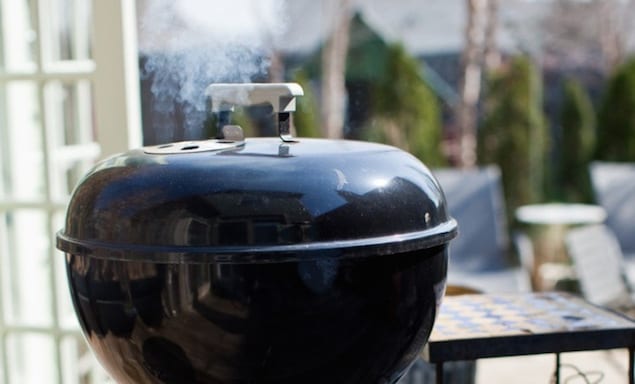 Mark Boughton Photography
Mark Boughton Photography
This article has been posted with permission and originally appeared as 55 Top Chef Tips on How to Grill on Relish
June 21st may be the “official” first day of summer. But we say summer starts the moment you dust off the grill and are able to serve up a smorgasbord of barbecued goodies. Whether you prefer gas or charcoal, there’s something to be gleaned from the grilling methods utilized by top chefs like Rick Bayless and Curtis Stone. Which is why we asked them to share their favorite tricks for al fresco cooking.
1. Banking your coals to one side of the grill makes all the difference. Cook the meat until charred in the “hot spot” (that is, over the coals), then let it coast to perfect doneness in the “cool spot.”
2. Think beyond burgers and steaks! One of my favorite things to grill is mussels: Lay them on the grill, wait for them to open, take them off, douse them in sauce. It’s really that easy.
—Rick Bayless, Chef, Red O Restaurant
3. Know thy grill. If you are using a gas grill to control your heat, there is no need to have it turned up all the way—you’ll burn that beautiful steak. If you are a charcoal aficionado, make sure you let your charcoal burn down and let the briquets get nice and white-hot. Don’t rush it; get your charcoal working a minimum of one hour before you plan on grilling.
—Peter Vauthy, Chef/Partner, Red, the Steakhouse
4. Organize and prep (wash, cut, oil, and season) everything in advance and place on a sheet pan ready for the grill. Organization will allow you to enjoy your grilling experience.
—Paul Virant, Chef/Owner, Perennial Virant & Vie
5. Make sure the item you are grilling has been taken out of the refrigerator at least 20 minutes before it goes on the grill. This way the meat is closer to room temperature and will cook quicker and more evenly. Doing this will also cause the middle to cook faster, making it easier to avoid charring the outside.
6. If applying a glaze or sauce on the meat (chicken, ribs, pork chops), remember that it’s best to cook the meat on the direct flame of the grill to get those awesome char marks, then glaze and cook through on a cooler part of the grill. This will ensure the flavor still penetrates the meat but the charred, burnt carbon crust doesn’t form due to burning at the early stage.
—Graham Elliot, Chef/Restaurateur, Graham Elliot Bistro & Primary Food & Drink
7. Keeping your grill in good condition will make life a lot easier and allow you to enjoy the grilling season to the utmost. At the beginning of your grilling season, give your grill one good cleaning. This should involve a strong cleaning agent (there are lots of environmentally-safe options out there). Soak the grates and scrub the body as well. If you are using gas or propane, you really want to clean out all your ports and potentially replace any stones or ceramic plates, depending on your make and model. After each and every use, clean the grates using a stiff bristled brush; stuff comes off really easy when the grates are hot and this leaves you prepped for the next time you fire the grill up.
—Albert Gonzalez, Chef, Apothecary Café & Wine Bar
8. Summertime is a great season to cook your freshly caught fish on the grill, but low heat and overcooking will quickly dry fish out. When grilling filets of fish, you must make sure you grill on high heat and have a good spatula on hand. Do not move your fish around once you place it on the grill, as it will break easily. Flip only once. Fish filets are best when a spice crust or rub is used. While grilling, use a basting of seasoned olive oil to help the fish ascertain its maximum flavor.
—Sean Brasel, Executive Chef/Co-Owner, Meat Market
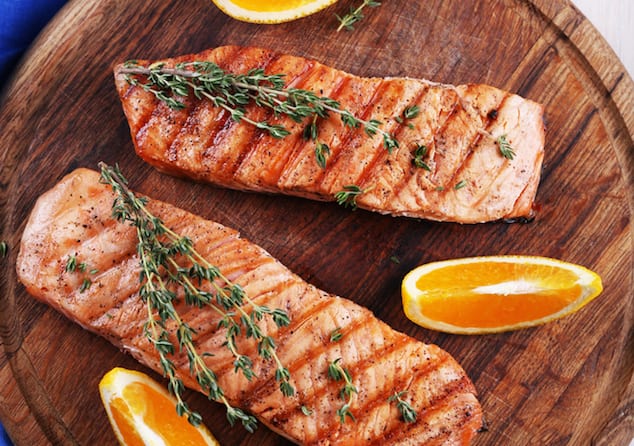 Shutterstock: Africa Studio
Shutterstock: Africa Studio
9. When grilling fish directly on a grill you want to use a firm-flesh fish like grouper, sea bass, salmon, swordfish or tuna. For more delicate fish, use a fish grid or basket or cook on a piece of aluminum foil.
—Paul Katz, Executive Chef, Old Town Pour House
10. Consider a paint scraper. It has a nice flat edge that you can use as you would a spatula to flip and turn meats and vegetables. It is also great to clean the barbie once you’re done. They’re durable, inexpensive and easy to find at any hardware store.
11. Fresh ginger is my secret ingredient when grilling. Not only does it add wonderful flavor, but it also tenderizes meat. I use it in conjunction with garlic, olive oil, cilantro, and chile pepper to make a delicious marinade for chicken, beef, lamb and pork.
—Curtis Stone, Chef/Owner, Maude
12. Trim away excess fat (too much fat can cause flare-up on the grill and give food a burned flavor). Cut to desired thickness—the best thickness for grilling is 1 or 1.5 inches; anything less will tend to dry out the meat.
13. Do not put barbeque sauce on food before grilling, or the food will burn. Brush sauce on [during] the last few minutes of cooking and right before serving. If you marinate a piece of meat before grilling, wipe off any excess marinade before placing it on the grill. Another option is to put a rub on the meat before grilling. To make a rub, combine equal parts kosher salt, black pepper, paprika and brown sugar; rub it on the meat and let it sit for a few hours before grilling it. It’s great for ribs, pork chops and chicken.
—Stew Leonard, Jr., CEO/President, Stew Leonard’s
14. Marinate your proteins prior to grilling—for up to 12 to 24 hours, depending on the protein and flavor profile/marinade.
—Wolfgang Birk, Executive Chef, Area 31
15. Add sweet ingredients to the marinade. Adding sweet ingredients to the marinade can help form appealing caramelized, crispy coatings on grilled meats.
—Michel Wahaltere, Executive Chef, Dorchester Social Eatery and Rooftop Lounge
16. When it comes to rubs, stick with pantry flavors. Try combining coffee (wechoose Lavazza, an authentic Italian brand) with other complementary flavors to enhance the taste. Other simple rub additions are crushed pepper and lemon zest. From the garden, we use rosemary, sage, laurel, mint, usually chopped fine, seasoned with salt and pepper and then add just a drizzle of olive oil to create a pasty rub.
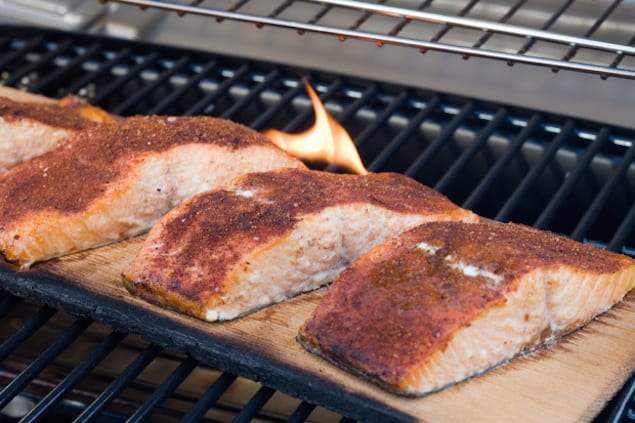
17. Our favorite way to grill is on wood. This allows us to pick and choose the smokiness depending on how compact the wood is. Most importantly, the flavors are always the best. Try this recipe for spiced plank salmon.
—Gabriele Corcos & Debi Mazar, Chefs/Hosts, Extra Virgin
18. To determine the fire temperature, you always can use a temp gun or your hands.Hold your hand, palm side down, five inches over the fire. If your hand gets hot immediately, the fire is very hot. If you can hold it for two or three seconds, the fire is hot; four to five seconds, the fire is medium; and if you can hold it for six seconds, the fire is low.
—Pascal Godé, Executive Chef, Alisal Guest Ranch & Resort
19. Have a tray or pan to season and then another for letting meat rest after grilling. A lot is still happening after you take meats off the grill, so be patient.
—Chad Dolezal, Co-owner/Executive Chef, The Hightower
20. When cooking by rotisserie, don’t marinate with fresh herbs, as they are likely to burn. And utilize a catch tray to catch the natural juices for sauces, stocks and gravy.
—Lucas Billheimer, Executive Chef, The Writing Room
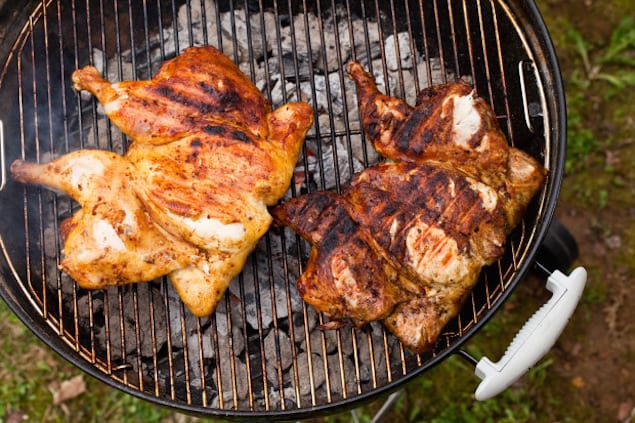 Mark Boughton Photography / styling by Teresa Blackburn
Mark Boughton Photography / styling by Teresa Blackburn
21. Use a brick on the grill. Purchase a cheap brick at a garden or home store and wrap in foil to weigh down your proteins when grilling. This is a great way to quickly grill a chicken.
—Nate Anda, Chef/Owner, Red Apron Butchery
22. When grilling, don’t be afraid to season. Make sure both sides of whatever you are cooking are properly seasoned with salt and pepper.
23. Never stab the meat with a fork to flip it over. These punctures allow juices to bleed out, further drying out the protein. Always use a spatula and/or tongs.
—Anthony Fusco, Executive Chef, STK Downtown
24. Use an oil with a high smoke point (i.e. grape seed oil or even better, rice bran oil). Using something with a higher smoke point versus the go-to extra virgin olive oil will give you better results with less burning.
—Jon Keeley, Executive Chef, Gemini Restaurant Group
25. Use a cast-iron griddle. Cast iron griddles are great when grilling (they also work on gas grills and indoor stoves). Put one over a wood fire, and it’ll be your new best friend. It heats up quickly and evenly and holds its temperature for a long time. Griddles ensure that you’ll always get a great sear on the meat and they help to retain moisture while preventing any burning or scorching you might get from cooking over an open flame.
26. Go Brazilian. At a Brazilian churrascaria, the picanha is one of the best cuts of meat. Basically, it’s the muscle directly over the sirloin with an adjoining layer of fat about half an inch thick still attached. To cook it, just score the fat layer in a crisscross pattern, salt it and place it on a ripping hot grill, meat side down, so that the fat basically bastes the steak during the beginning of the cooking process. Turn the steak over onto its sides and then the fat side and continue to cook to your liking. It’s the best and easiest cut of steak you can make.
—Jesse Schenker, Executive Chef/Owner, Recette and The Gander
27. Big meat, low heat. This is true for the double-cut pork chop or any meat. Americans have a tendency to fire up the grill and char away, but especially for large cuts, turning down the heat is essential to get juicy meat and a super flavorful crust.
28. Use a thermometer. A digital thermometer is one of the most important tools I can recommend. The chefs in Argentina grill almost every day over huge charcoal and wood fires, so they’re masters at knowing when their meat is cooked to perfection, but that only comes with years of practice. A thermometer takes the guesswork out of the equation, so there are no more of those “Is it done yet?” arguments.
—Peter Kaminsky, Chef/Author, The Essential New York Times Grilling Cookbook
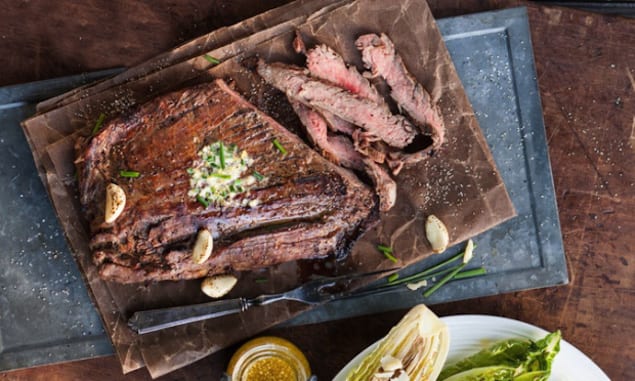 Try this recipe for Balsamic-Marinated Flank Steak
Try this recipe for Balsamic-Marinated Flank Steak
29. Let it cook.If you are grilling steak, do not touch it. All too often people want to break out their tongs and start moving steaks around. After you’ve placed your steak on the grill, pick a point on the steak and make that point 10 o’clock. Let it sit for two minutes, then turn to 2 o’ clock. Let it sit for two more minutes, then flip the steak. If the marks aren’t beautiful, you’ve got another chance on new side. If the marks are beautiful, just finish cooking the steak until the internal temperature is 120F. I’ve been grilling for a living nearly my entire life and I still use a meat thermometer. Get one, they’re worth it!
—Vic Newgren, Executive Chef, SideDoor
30. Go right into the coals. Wrap different ingredients into aluminum foil packets and cook them directly on top of the charcoal. For example, wrap a whole fennel bulb with the fennel fronds, then place it in a foil package with garlic, salt, olive oil, coriander seeds and orange zest. Throw the package on top of the coals for a few minutes until the bulb is tender. Serve this alongside whatever grilled meats you’re serving.
—Josiah Citrin, Chef/Owner, Melisse
31. Combining oak with a gas grill will set you apart from other gas grills in the neighborhood. Purchase a disposable aluminum tray (with a lid) and place small pieces of oak wood and wood sawdust in tray and place the lid on top. Poke about a dozen holes in the lid and place the aluminum tray directly on the gas-fired grill grates. As the tray heats up, the wood will begin to smolder and smoke, imparting the smoky flavor desired. You can control the amount of smoke in the food by simply removing the aluminum tray back and forth to the hot grill.
—Steve Redzikowski, Chef/Owner, OAK at fourteenth & Acorn
 Try this recipe for grilled peach ice cream
Try this recipe for grilled peach ice cream
32. Don’t be shy about using the grill for “cold” dishes. But only a few seconds will do. For instance, I update a classic shrimp cocktail by popping the shrimp on the grill for less than a minute, and then marinate them again while they are chilling to add another dimension of flavor. I also like to do this with tuna for salads in the summer.
—Matthew Lightner, Former Executive Chef, Atera
33. It is hard to imagine ever pulling pork again without the “CLAWS”. They allow you to pick up the whole tender shoulder from the smoker and pull it while it’s still ripping hot.
—Doug Psaltis, Chef/Partner, Bub City
34. Use flavored salts to add an extra layer of flavor to foods without adding another ingredient or component. I like to use hickory-smoked salt to add smoky flavor to foods like homemade potato chips or a ghost chili salt to add heat and salinity to tuna sashimi.
—Ernesto Uchimura, Executive Chef/Partner, Plan Check Kitchen + Bar
35. Steaks are a great reward—buy them to celebrate a good hard weeks’ worth of work. I love all different kinds of steak because each offers something different and wonderful. Filet mignon is lean and tender. Sirloin strip steaks are thick and juicy with flavor. Rib eyes are like the prime rib of steak with that tender, juicy, fatty outside layer. Porterhouse gives you the best of both worlds: a sirloin and a tenderloin. Flank steak is fun when the right flavors have tenderized its lean interior, plus it’s a healthier choice.
—Marjorie Druker, Founder/Executive Chef, New England Soup Factory & The Modern Rotisserie
36. Even though you are outside, take the time to double check that your work area is well ventilated, and that the smoke from the grill won’t get caught in any awnings or overhangs.
37. Make sure to not only season your food, but also season your grill. Food will stick less and the grill will pass on great flavor.
—Tom Van Lente, Executive Chef, TWO Restaurant and Bar
38. Brush a very thin layer of mayonnaise onto fish (especially whole fish) before grilling. This is a sneaky chef trick to make sure the fish doesn’t stick to the grill. The emulsified fat stays put so that the fish will lift off of the grill, yet the excess will drip off when heated. Even if you are not a fan of mayo, you’ll be a fan of this trick.
—Brad Farmerie, Executive Chef, Public & Saxon + Parole
39. Study other cultures’ cuisines to pick up new techniques! We have a great team of Jamaican chefs who work with us every summer. Each year I ask them for a jerk chicken recipe and attempt to duplicate it in my own kitchen, but something is always missing. This past year one of them let me in on a secret: the key to a great jerk marinade is to use yellow onion water as the medium to puree all the chilies. I now use this same technique to marinade swordfish and chicken.
—Karsten Hart, Executive Chef, Castle Hill Inn
40. Your grill needs to be very hot, and do not use oil to grease the steak. Instead, let the natural fat render out on the grill. Try not to get any flare-ups, as flare-ups cause carbonization and a bitter, burnt flavor. If you’re looking for extra flavor, throw a few wood chips on the fire and let the smoke flavor your meat.
—Christopher Lee, Executive Chef, The Forge
41. Soak wood chips in water for about 30 minutes before using. Hickory wood chips create a pungent aroma typical of Southern cooking. Mesquite gives food a sweeter and more delicate aroma.
—Laurent Tourondel, Chef/Partner, Arlington Club
42. Most people make the mistake of over grilling and drying out chicken. Pull the chicken off the grill a few minutes early and let it rest on its side and it will continue to cook through.
—Michael Psilakis,Chef/Owner, Kefi, FISHTAG & MP Taverna
43. Seeing as the grill can draw too much moisture from your meat, I usually have a spritzer ready with vinegar, citrus and a little water. I spritz on the protein as it is grilling to keep the moisture there.
—Carolina Diaz, Chef, Filini Bar & Restaurant
44. Keep it simple. With vegetables and proteins alike, all you need is a sprinkle of Aleppo pepper and Maldon sea salt right when it comes off the grill. Whether its asparagus, ramps or steak, there is nothing better than highlighting the natural flavors of the ingredient by adding a dash of pepper and salt.
—Dan Silverman,Executive Chef, The Regency Bar & Grill at Loews Regency Hotel
45. Add wood chips to your grill for a nice smoky flavor. Prior to adding to the grill, soak the wood chips for 20 minutes in water, apple juice or alcohol. Next, place chips on a piece of aluminum foil and place directly over the flame. Once the chips begin to smoke, move them onto the rack. When you are grilling your chickens or ribs, close the lid and let the smoke permeate the meat.
—John Lechleidner, Chef de Cuisine, WP24 Restaurant
46. Marinate your proteins a day in advance with fresh herbs (rosemary, thyme, savory, etc.), fresh chopped garlic and very little olive oil so it does not drip and catch on fire while grilling. You want to marinate one day out so as to give your meat good flavor.
—Cedric Tovar, Executive Chef, TESSA
47. Before grilling, I highly recommend brining your meat. During the brining process, the muscle fibers absorb the liquid brine, distributing the flavors throughout the meat. It is best to brine lean meats—such as pork, chicken, turkey and lean beef—to avoid drying and shrinkage during the cooking process. A basic brine combines sugar, salt, some herbs, shallots and garlic. Bring it to a boil, let it cool and pour it over the meat. Let the meat soak for at least two hours. The end result will be much tastier and juicier meat!
—Sylvain Delpique, Executive Chef, 21 Club
48. No cookout is complete without a Mai Tai. I whip up large batches of the cocktail so guests can serve themselves and I can keep my focus on cooking/hosting. My beloved recipe includes orgeat syrup, three kinds of rum (white, dark, Mount Gay), Cointreau and pineapple juice. The drink should always be brown, never red, in color.
—Lydia Shire, Chef/Owner, Scampo
49. For a grilled dish that will knock your guests’ sandals off, try Backyard BBQ Octopus. Start with fresh, cleaned baby octopus; boil in a classic clambake mix of salt, pepper, Old Bay seasoning, chopped celery, onion and fresh-squeezed lemon juice until tender (if you can pass a toothpick through with little resistance, it’s done!). Then marinate in extra virgin olive oil, salt, pepper and crushed red pepper; and finish by grilling on a piping hot wood-burning or charcoal grill. I jazz this up at Bay Kitchen Bar with a Mediterranean dressing of heirloom tomatoes, Kalamata olives, lemon, shallot and herbs. My son, partner in the restaurant and wine director Adam Miller, recommends pairing the octopus with chilled rosé from Wölffer Estate for a summer BBQ to remember.
—Eric Miller, Chef/Owner, Bay Kitchen Bar
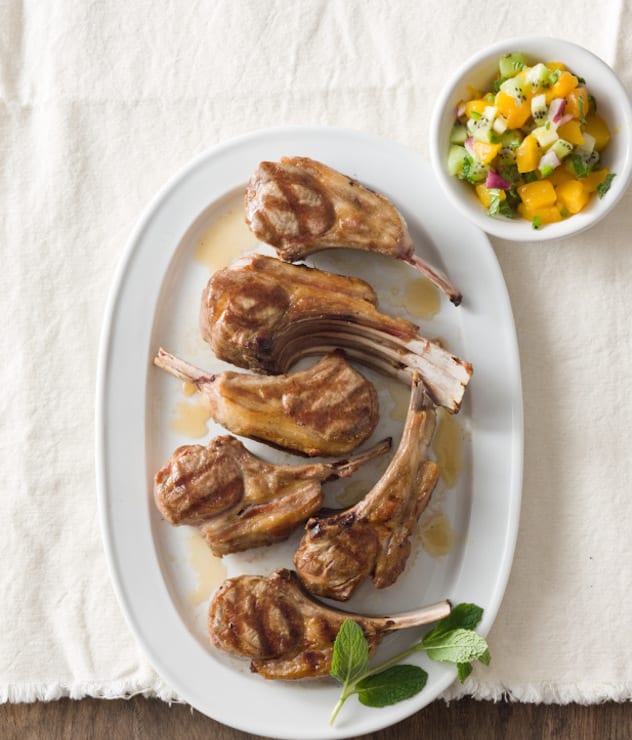 Grilled Lamb Chops with Kiwi Mango Relish
Grilled Lamb Chops with Kiwi Mango Relish
50. Most people don’t consider grilling vegetables when they grill steak or burgers, but when you think about it, it’s the best way to complement the meal, especially using charcoal or wood. To make it easier, pick up one of those grilling pans for vegetables that help keep small pieces from falling through the grate. Potatoes cook in about 15 minutes if you cut them small enough. Always include onions; they will add a lot of flavor to any vegetable mix. You can even do fruits such as tomatoes, peaches and pears. The key is to cook the vegetables on the hot spot of your grill. If you grill steaks, pork chops, or even hamburgers, once you pull them off, stick your vegetables in that spot and you’ll pick up a little bit of that flavor as well.
—Jack Gilmore, Executive Chef/Owner,Jack Allen’s Kitchen
51. My favorite thing to grill is probably soft shell crabs, because they’re incredibly easy to make. Little bit of salt, pepper and oil—tossed in a little bit of garlic—is all you need. After grilling, add a squeeze of roasted or crushed lemon and a little drizzle of olive oil to finish it off.
—Govind Armstrong, Chef/Owner, Post & Beam and Willie Jane
52. Be careful when it comes to oysters. The super hot, dry heat of a grill is not the best thing for oysters, so when grilling it is best to create a moist environment. One way to do that is to keep the grill at a fairly low temperature and cover the oysters by putting the top down on the grill or covering them with a pan. You can also put the oysters on a medium to low heat grill and cover them with a wet towel or burlap sack, which helps to steam them.
—Dylan Fultineer, Chef, Rappahannock Restaurant
53. When grilling lamb, you want to make sure you’re not losing any moisture. To make sure I keep all the natural juices in, I grill lamb whole before chilling it all the way through, slicing and marinating in red wine. Once marinated, I’ll finish it off in the oven. With this technique, the lamb gets the delicious smoky flavor from grilling while still staying juicy and tender.
—Jeremy Lieb, Executive Chef, Boca
54. My secret summer cocktail ingredient: Tarragon. All that heat from the grill is going to make you thirsty. Make a refreshing cocktail with tarragon. It’s a great herb for lighter summer cocktails and spirits like gin, vodka and even tequila.
—Brian Dayton, Beverage Director, OAK at fourteenth & Acorn
55. Try grilling seasonal fruits for dessert. They will pair perfectly with cheese!
—Sarah McIntosh, Chef/Owner, épicerie
Offering more than 14,000 recipes plus features and DIYs on cooking, dining and entertaining, Relish celebrates America's love of food. Relish is about honoring cooking traditions while exploring new trends and ideas, which is why millions of people turn to both Relish.com and Relish Magazine for special occasion recipes, quick and easy weeknight suppers and culinary adventures.


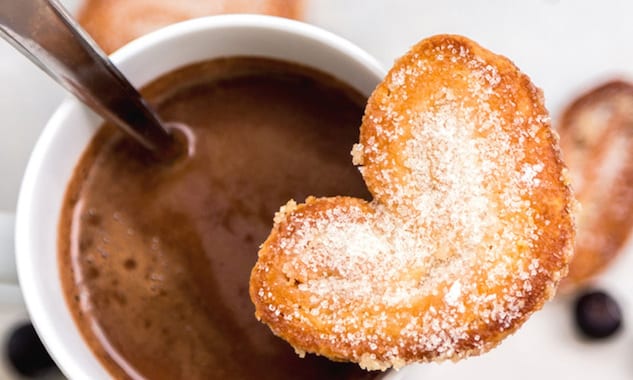
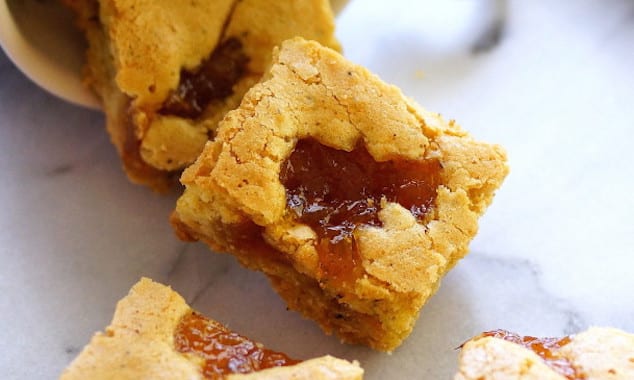
Great ideas! What is the best gas grill. Getting for hubbie. Thx